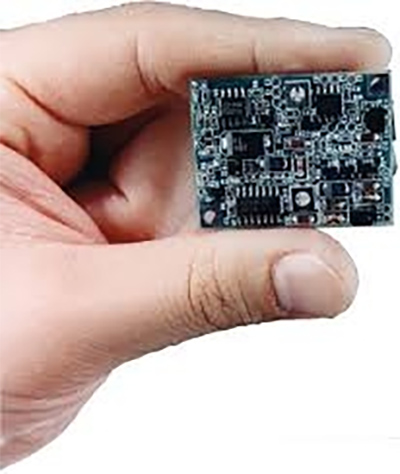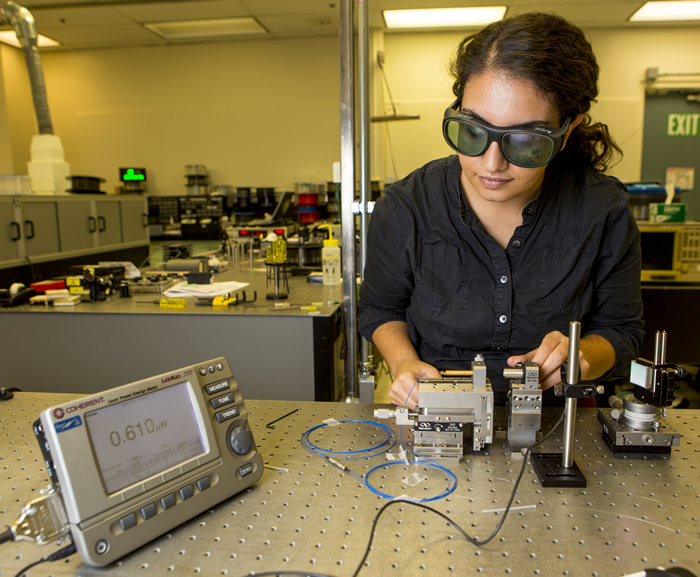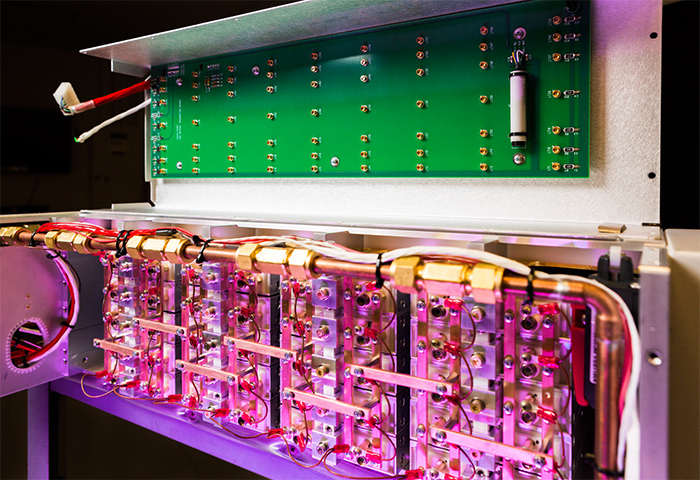Transferring NIF&PS Technology

Helping Shape the Future of Technology
Technologies developed or improved at LLNL have led to industry-defining partnerships and products that enhance the nation’s competitiveness and improve the lives of millions of Americans (see Lasers and Optics).
A leading example is the enhancement and commercialization of laser peening—using intense laser light to improve the quality of a material. The technology originated at Battelle Memorial Institute in the 1970s and was first commercialized by LSP Technologies in 1975 but did not achieve significant market penetration until LLNL introduced a new laser architecture that provided critical new functionality.
In 2003, LLNL scientists joined with an LLNL CRADA (Cooperative Research and Development Agreement) partner, Metal Improvement Company (MIC)—today part of Curtiss-Wright Corporation—to develop the technology until it was mature enough to stand on its own.
Today, MIC’s laser peening can exponentially extend the lifespan of an F-22 fighter jet’s airframe. MIC has treated jet engine fan blades on every Airbus A340 passenger plane and hundreds of Boeing 777s and 787s. It’s the third-best royalty-producing technology in Lab history.
Laser-Driven Explosive Bonding
LLNL is now offering the opportunity to license and commercialize an extension of laser-peening technology called high velocity laser accelerated deposition (HVLAD) for controlled laser-driven explosive bonding. HVLAD was selected by R&D Magazine to receive one of the more than 60 R&D 100 Awards won by the NIF & Photon Science Directorate and its predecessor, the Laser Programs Directorate—often in collaboration with commercial partners—since 1978.
Micropower Impulse Radar
 The micropower impulse radar chip. Both the radar transmitter and receiver are contained in a package measuring just two square inches.
The micropower impulse radar chip. Both the radar transmitter and receiver are contained in a package measuring just two square inches. LLNL’s most widely licensed technology is micropower impulse radar (MIR), used for sensing and measuring distances to objects in proximity to each other. Known as “radar on a chip,” MIR was developed by the Lab’s Laser Programs in the early 1990s. Unlike conventional radar, which sends out continuous waves in bursts, MIR uses very short electromagnetic pulses and can detect objects at much shorter range.
The technology has become LLNL’s fastest-growing technology transfer activity, primarily because of its low cost and extraordinary range of applications. Among the more than 100 commercial applications that have been identified are:
- Vehicles: parking assistance, backup warnings, pre-collision detection, and smart cruise control (a system that measures the distance between vehicles and releases the throttle and applies the brakes if they get too close)
- Appliances: stud finders and laser tape measures
- Security: home intrusion motion sensors and perimeter surveillance
- Search and rescue: MIR can detect the beating of a human heart or respiration from long distances; it was used in the search for 9/11 survivors.
Diode-Based Additive Manufacturing
Another successful partnership grew out of technology originally developed to smooth out and pattern NIF’s laser beams. Diode-based additive manufacturing (DiAM) uses high-powered arrays of laser diodes, a Q-switched (pulsed) laser, and a specialized laser modulator developed for NIF called an optically addressable light valve (OALV) to 3D-print metal objects faster than ever before.
In 2016, patents for the DiAM technology, which can flash-print an entire layer of metal powder at a time, were licensed to Seurat Technologies, a startup company that envisions bringing an industrial metal printer with unparalleled speed and resolution to market.
Using DiAM, large metal objects could be printed in a fraction of the time compared to metal 3D printers on the market today, expanding possibilities for industries such as aerospace and automotive requiring larger metal parts. The speed and degree of design flexibility afforded with the DiAM method is potentially far beyond that of current power-bed fusion-based systems.
Pushing the Frontiers in Lasers and Optics
Development of a state-of-the-art laser system such as NIF required precision engineering of laser materials and optics well beyond commercial products available at the time. By transferring LLNL technology and working closely with vendors on new technology developments, the Laboratory has shaped the technology infrastructure of the nation’s precision optics industry.
The results of LLNL optics R&D include new crystalline lasing materials; large, rapidly grown crystals for optical switches and frequency conversion applications; continuous-pour defect-free laser glass; methods for producing optical surfaces and coatings of extraordinary quality and damage resistance; and optical characterization metrology of unprecedented precision. This work has enabled advances in fields as disparate as semiconductor lithography, astronomy, and high energy density physics.
The Laboratory also has developed fiber-optic cable technology with the potential for greatly increasing the capacity of the world’s broadband telecommunications networks. The lab’s E-band fiber optic amplifier, a project created by a team of researchers from NIF & Photon Science and funded by LLNL’s Innovation and Partnerships Office (IPO), recently received a $150,000 award from the Department of Energy’s Office of Technology Transitions. In addition, the amplifier won a 2018 TechConnect Defense Innovation Award, which recognizes technologies judged to have a “potential positive impact” for warfighters and national security.
 NIF & Photon Science postdoctoral researcher Leily Kiani tests a new optical fiber that could double the bandwidth of fiber-optic cables. Credit: Jason Laurea
NIF & Photon Science postdoctoral researcher Leily Kiani tests a new optical fiber that could double the bandwidth of fiber-optic cables. Credit: Jason Laurea As the Laboratory advances each dimension of laser and optics technology, companies can follow along and adopt them as they become available. For other examples of current laser and optics technologies available for commercialization, see the IPO Website or contact David Dawes at dawes4@llnl.gov.
Isolators for High-Power Lasers
Anticipating the next generation of lasers is another fertile ground for partnerships with NIF&PS researchers. Scientists expect these lasers to be so powerful, current optics technologies won’t be able to withstand them.
A current CRADA with Electro-Optics Technology (EOT) aims to address one of these issues. Known for their diode-like Faraday isolators—permitting light to pass in one direction only while preventing harmful backward propagation—EOT, among other industry leaders, got a call from Laboratory researchers with experience in high-power laser performance and component cooling looking for ways to push the limits of isolator technologies.
EOT was looking to advance applications of new materials, which fit perfectly into the need for high-power isolators. Together, EOT and LLNL are close to producing a marketable product that will benefit the laser industry as a whole and prepare the Laboratory for advanced high-power laser systems.
High-Repetition-Rate Petawatt Laser
One such system is the new HAPLS pulsed-laser system recently installed in the European Union’s Extreme Light Infrastructure (ELI) Beamlines facility in the Czech Republic. HAPLS (the High-Repetition-Rate Advanced Petawatt Laser System), designed, developed, and delivered by LLNL, integrates a number of new, efficient, high-power laser and optical technologies—such as next-generation compressor gratings that could boost the performance of the world’s ultrafast high-power laser systems by as much as 20 percent—that researchers believe will eventually lead to the lasers necessary for inertial fusion energy.
A powerful tool for its customer, HAPLS is also a window for scientists into the future of high-power pulsed lasers and a possible fusion power plant. HAPLS won a regional award for technology transfer from the Federal Laboratory Consortium in 2018; and LLNL, in partnership with Tucson, Arizona-based Lasertel Inc., won a 2015 R&D100 Award for HILADS (the high-power intelligent laser diode system, a key component of HAPLS. For more information on the NIF & Photon Science Advanced Photon Technologies program, contact Craig Siders at siders2@llnl.gov.
 LLNL researchers partnered with Lasertel Inc. to develop the world’s highest peak power laser diode arrays, representing total peak power of 3.2 megawatts, to power the High-Repetition-Rate Advanced Petawatt Laser System. To drive the diode arrays, LLNL developed and patented a completely new type of pulsed-power system, which supplies the arrays with electrical power by drawing energy from the grid and converting it to extremely high-current, precisely shaped electrical pulses.
LLNL researchers partnered with Lasertel Inc. to develop the world’s highest peak power laser diode arrays, representing total peak power of 3.2 megawatts, to power the High-Repetition-Rate Advanced Petawatt Laser System. To drive the diode arrays, LLNL developed and patented a completely new type of pulsed-power system, which supplies the arrays with electrical power by drawing energy from the grid and converting it to extremely high-current, precisely shaped electrical pulses. 


